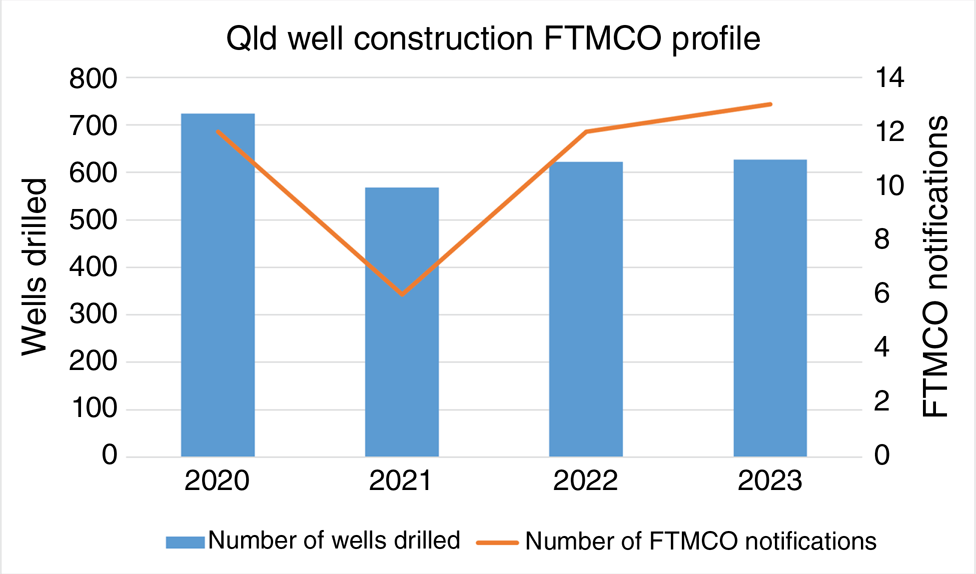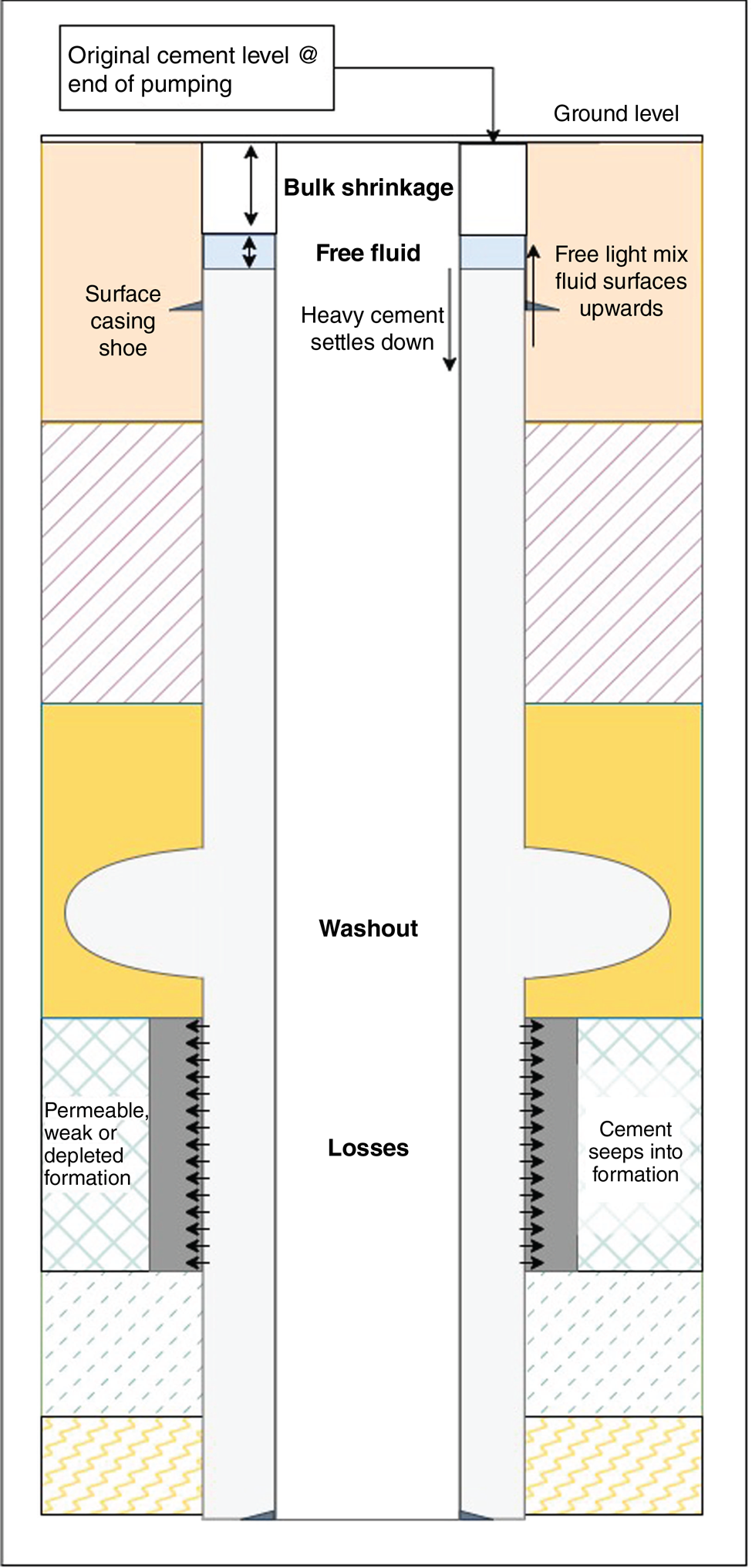Primary cementing practices and compliance in Queensland’s petroleum wells
Ahmed Harfoush A * and Chris Barrand AA

Ahmed Harfoush is a Petroleum Engineer (Wells) within the Petroleum and Gas Inspectorate at Resources Safety & Health Queensland. He has over 15 years of diverse experience in the petroleum industry, specialising in well operations, including primary cementing, plug and abandonment, well integrity, safety management systems, regulatory compliance, and risk management. He is also the Co-chair of the Well Integrity Special Interest Group for the Society of Petroleum Engineers Queensland Section. Ahmed holds an MSc in Petroleum Engineering from Heriot-Watt University, is a Chartered Professional Engineer, and a Registered Professional Engineer of Queensland (RPEQ). |

Chris Barrand serves as the Executive Petroleum Engineer (Well Operations) within Resources Safety & Health Queensland since July 2022. He has 18 years’ experience in upstream oil and gas operations in Australia and Africa. Chris has held roles in both operating and service companies, focussed on drilling and completions operations, well construction and stimulation, completion and ALS technologies. Chris holds a Bachelor’s in Engineering (Petroleum Engineering), is an active member of the Society of Petroleum Engineers, and the Chairperson of the SPE Queensland Chapter. |
Abstract
Primary cementing is a crucial aspect of petroleum well construction, ensuring long-term well integrity, preventing fluid migration, and protecting groundwater. In Queensland, Resources Safety & Health Queensland (RSHQ) Petroleum and Gas Inspectorate enforces the Code of Practice for the construction and abandonment of petroleum wells and associated bores in Queensland, which outlines engineering and technical requirements for well construction and abandonment. Between January 2020 and December 2023, industry operators drilled 2541 wells and reported 43 failures to meet primary cementing objectives (FTMCOs), prompting the Inspectorate to conduct industry-wide audits. The audits focussed on compliance with cementing practices, formal safety assessments, slurry design, laboratory testing, verification procedures, and factors contributing to slumping and failure to reach the designed top of cement (TOC). Key findings highlighted gaps in formal safety assessments, a tendency to delegate cement slurry design to contractors without rigorous technical oversight, and inconsistencies in laboratory testing documentation. Additionally, verification procedures were not always aligned with regulatory requirements, and cement losses presented significant challenges towards the slumping and TOC deficiencies. To enhance primary cementing practices, the paper recommends strengthening oversight of cementing contractors’ technical capabilities, improving verification procedures, and ensuring consistent comprehensive risk assessments. Aligning cement verification procedures with regulatory requirements and adopting best practices for mitigating cement losses will improve well integrity and regulatory compliance.
Keywords: audits, bulk shrinkage, cement excess, cement losses, cement slurry design, cementing best practices, cementing contractors, coal seam gas, Code of Practice, depleted zones, failure to meet cementing objectives, formal safety assessment, laboratory testing, lost circulation materials, petroleum wells, primary cementing, regulatory compliance, risk assessment, slumping, Surat Basin, top of cement, verification procedures, zonal isolation.
Introduction
Resources Safety & Health Queensland (RSHQ) is the independent regulator of worker safety and health in Queensland’s mining, quarrying, petroleum, gas and explosives industries. Within RSHQ, the Petroleum and Gas Inspectorate focusses on the petroleum and gas sector, with a vision of zero serious harm.
The Inspectorate administers the Code of Practice for the construction and abandonment of petroleum wells and associated bores in Queensland (RSHQ 2019) (the code). The code outlines engineering and technical requirements for constructing, operating, and decommissioning wells.
Primary cementing is critical in well construction, ensuring long-term well integrity throughout its lifecycle. The code specifies various requirements, verification, and evaluation methods to assess primary cement jobs. Failures in primary cementing objectives (FTMCOs) can lead to integrity issues, complicate well maintenance, and increase the cost and complexity of decommissioning due to remediation efforts.
Industry operators must notify the Inspectorate if they cannot verify the performance of primary cementing operations using at least three verification and evaluation methods. Between January 2020 and December 2023, the industry drilled 2541 wells, with 43 FTMCOs reported to the Inspectorate (Fig. 1).
Chart showing wells drilled in Queensland between 2020 and 2023 and the FTMCO notifications lodged.

The Inspectorate audited several operators representing 98% of the wells drilled within Queensland, during the above period, on primary cementing practices. These audits aimed to:
Ensure the auditee’s safety management system (SMS) includes a formal safety assessment of well integrity risks related to primary cementing activities
Compare operator-provided information against the requirements of section 3.6.2 of the code
Improve understanding of the mechanisms contributing to FTMCOs.
Scope and methods
An analysis of the FTMCOs lodged between January 2020 and December 2023 revealed:
77% of the notifications belonged to Surat Basin wells
They were for cementing of production or intermediate casings
The most common failure mechanism was the inability to achieve the designed top of cement (TOC).
Additionally, discussions with operators highlighted slumping as a recurring issue. Slumping occurs when cement returns to the surface during the cement job but subsequently settles, lowering the cement level. Slumping may create an increased risk of surface corrosion due to the cavity left at the top of the annulus and is not classified as an FTMCO unless it compromises mandatory cementing intervals.
Slumping and failure to reach designed TOC share similar contributing factors, including (Fig. 2):
Bulk shrinkage: the final volume of hydration product is less than the initial cement and water volume. This occurs when fluid entry into the matrix is restricted (API 1997)
Free water level: free water rises while the slurry sets due to density differences, leading to downward slurry movement
Losses into the formation: caused by permeability, formation weakness, zonal depletion
Severe washouts: these can significantly impact cement placement if not properly accounted for.
Given these findings, the audits focussed on:
Cementing practice compliance in the Surat Basin
Key factors contributing to TOC deficiencies and slumping.
To assess compliance, the Inspectorate selected two criteria from the Petroleum and Gas (Production and Safety) Act 2004 and 11 criteria from the code most relevant to the audit objectives. Ninety-one wells were selected for evaluation.
The Inspectorate used the following investigative tools during the audits:
Discussion results
Compliance with the code
The audits observed general compliance with the following cementing requirements:
Cementing production and intermediate casing designs required cement to extend at least 50 m inside the previous casing shoe
Free water content in cement was specified as less than 2%, following API RP 10B-2 (API 2024) guidelines
Pressures during cementing operations, particularly before plug bump, were recorded to assess cement column height and potential downhole problems
Wiper plug assemblies were mandated to ensure plug bump and pressure testing before cement curing.
The Inspectorate identified the following gaps:
Formal safety assessment: some operators lacked a formal safety assessment and instead relied on embedded controls within the technical standards, engineering designs and programs. Where risk assessments were present, they were either included in high-level risk registers or attached as addendums to generic programs. For operators who incorporated risk assessments within programs, the depth and quality of cementing risk identification varied significantly between programs. Where risk assessments were found, not all cementing risks were thoroughly considered.
Cement design: operators typically delegated cement slurry design to cementing contractors, adopting an outcome-based approach. Operators provided functional specifications and expected contractors to develop compliant cement recipes verified through laboratory testing. However, the audits indicated a strong emphasis by operators on overseeing the contractors’ workplace health and safety compliance, with a gap in overseeing their technical compliance. To assess contractors’ technical capabilities, more work is required to ensure that cement slurries are optimally designed for well conditions, aligning with industry best practices and regulatory expectations.
Laboratory testing: most laboratory reports lacked direct comparisons between test results and design requirements. Fluid compatibility between cement, mix water, and spacers was often unrecorded. Water sources were often vaguely identified, creating uncertainty about whether the wells were cemented using the same water source used during testing. This issue was particularly relevant in programs covering multiple wells. Furthermore, contrary to legislative requirements, laboratory tests were not consistently included in WCRs.
Verification procedures: even though the code mandates verification procedures for primary cementing jobs, only half of the operators included cement verification as well acceptance criteria (WAC) in their drilling programs. However, it appears that cement verification WACs – where present – were not fully aligned with table 3 of the code (Table 1), possibly because table 3 is only mentioned in the FTMCO reporting requirements. Only one operator explicitly required the production of resulting records to demonstrate the success of WACs in their program. Another operator referenced the need for verification per table 3 in their cementing standard, but the specific verification steps were not outlined in their programs.
LOT, leak-off test; CSG, coal seam gas.
Factors contributing to slumping and top of cement deficiencies
Slumping was not well documented across the industry. While one operator used plumb bobs and annular fluid top-up volumes to measure slumping, most did not monitor or quantify the issue. This lack of documentation poses a risk of undetected integrity issues over time. The following are the findings on the key factors contributing to the slumping/TOC deficiencies issues:
Losses: cement losses, particularly in the depleted coal seams, were identified as a significant risk, especially for frac wells. Losses primarily occurred due to depleted zones, high permeability or when formation fracture pressure was exceeded. The audits revealed that most operators mitigated these losses by adding lost circulation materials (LCMs) into spacers and cement blends. Other mitigation practices varied between operators. One effective mitigation approach observed was addressing drilling losses before commencing cementing operations. One operator implemented a no-go loss rate threshold of 10 bbl/h, ensuring that losses were controlled before proceeding with cementing. The operator also used cement with thixotropic properties to reduce losses and slumping. Additional methods to mitigate cement losses included light slurries, two-stage cementing, and secondary Annular Casing Packers deployment.
Bulk shrinkage: most operators used shrinkage-limited slurry, but only one mandated expansion ring test for all lab tests. The same operator required zero bulk shrinkage for gas-tight slurries. Another operator only performed expansion ring tests when trying new slurries. Quality assurance deficiencies are suspected because of lack of systematic bulk shrinkage investigations.
Washouts: wireline logs suggested minimal risk of overgauging and washouts in the Surat Basin. Washouts did not significantly contribute to cementing failures.
Cement excess: most operators could not consistently justify the cement excess requirements stipulated in their documentation, due to a loss of corporate memory regarding the original reasoning behind these standards. Excesses are calculated on field experience.
Conclusion
Audits on primary cementing in the Queensland Surat Basin and failure to meet cementing objective notifications identified a few gaps in cementing practices. Operators must conduct comprehensive risk assessments and integrate controls into cementing standards, designs, and programs. Operators must ensure explicit cement verification procedures are included in their drilling programs and strengthen the procedures’ alignment with table 3 of the code. This would enhance compliance and improve cementing performance assurance.
Further regulatory engagement with cementing contractors is necessary to ensure well-adapted slurry designs. The main failure mechanism for the FTMCOs was the failure to achieve the designed TOC. Upon investigation, losses are the primary cause for this failure mechanism. The success of primary cementing activities to ensure casing integrity and zonal isolation depends on multifaceted factors, of which only a few were explored in the audits. Future audits will explore additional factors impacting primary cementing outcomes.
Data availability
The data that support this study cannot be publicly shared due to ethical or privacy reasons and may be shared upon reasonable request to the corresponding author if appropriate.
Acknowledgements
The authors acknowledge all parties involved in the audit process, the auditees, and the audit team: Nataly Chaustre, Anthony Morton and Dan De Clara.
 Ahmed Harfoush is a Petroleum Engineer (Wells) within the Petroleum and Gas Inspectorate at Resources Safety & Health Queensland. He has over 15 years of diverse experience in the petroleum industry, specialising in well operations, including primary cementing, plug and abandonment, well integrity, safety management systems, regulatory compliance, and risk management. He is also the Co-chair of the Well Integrity Special Interest Group for the Society of Petroleum Engineers Queensland Section. Ahmed holds an MSc in Petroleum Engineering from Heriot-Watt University, is a Chartered Professional Engineer, and a Registered Professional Engineer of Queensland (RPEQ). |
 Chris Barrand serves as the Executive Petroleum Engineer (Well Operations) within Resources Safety & Health Queensland since July 2022. He has 18 years’ experience in upstream oil and gas operations in Australia and Africa. Chris has held roles in both operating and service companies, focussed on drilling and completions operations, well construction and stimulation, completion and ALS technologies. Chris holds a Bachelor’s in Engineering (Petroleum Engineering), is an active member of the Society of Petroleum Engineers, and the Chairperson of the SPE Queensland Chapter. |



